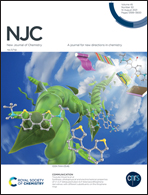Electrocatalytic, photocatalytic, fluorescence sensing and CO2RR properties of a series of homopolymolybdate hybrid coordination polymers†
Abstract
By using three different organic ligands, four homopolymolybdate-based coordination polymers were successfully synthesized, namely [Cu(MET)2][H2(γ-Mo8O26)] (1), [Zn(MET)2(H2O)2][H2(γ-Mo8O26)] (2), [Cu2(pca)2(H2O)4(β-Mo8O26)0.5]·H2O (3) and [Cu(bpy)(Mo2O7)] (4) (MET = 4-(3-imidazol-1-yl-ethyl)-4H-[1,3,4]triazole, pca = 2-pyrazinecarboxylic acid, bpy = 2,2′-bipyridyl). The asymmetric ligand MET induces the 1D chain structures of 1 and 2. Both the N and O donors in pca coordinate with the metal ions to induce the formation of a 3D framework of 3. Coordination polymer 4 shows an infinite Mo–O chain covered with [Cu(bpy)]2+ subunits. The carbon paste electrodes (CPEs) of 1 and 4 possess excellent multifunctional electrocatalytic activities for the reduction of KNO2, H2O2, and KBrO3 and the oxidation of ascorbic acid (AA). Coordination polymers 1–4 show photocatalytic activities for the degradation of methylene blue (MB) under ultraviolet irradiation. The best photocatalytic effect of 4 can reach 64.2%. The CO2 electrocatalytic reduction (CO2RR) performances of the coordination polymers were also studied. Furthermore, coordination polymers 1 and 2 show fluorescence sensing properties for Hg2+. 1-CPE and 4-CPE can act as nitrite and H2O2 amperometric sensors. For example, the response time of 1-CPE for nitrite was 4.12 s and the detection limit was 8.45 × 10−6 M. In fluorescence sensing experiments, the fluorescence intensities decrease by more than 72.9% when the Hg2+ concentration is 100 μM.



 Please wait while we load your content...
Please wait while we load your content...